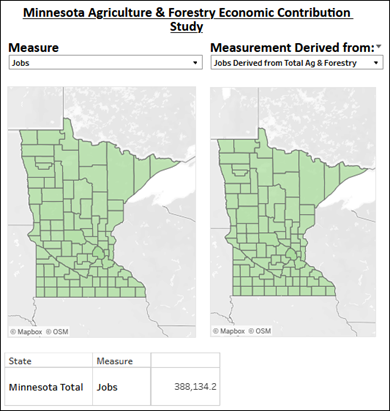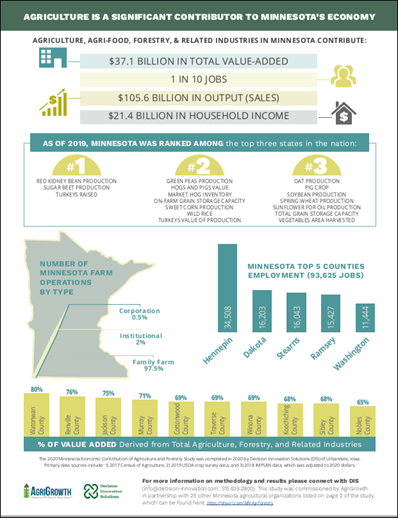Every 4-5 years our Team gets a wave of requests to estimate the economic contribution of agriculture for a number of organizations in many states in the Midwest and beyond. For example, we are at various stages of estimating the contribution of agriculture (and forestry in some cases) at the state, county and federal congressional district levels in the following states:
- Iowa
- Illinois
- Nebraska
- Minnesota
- North Dakota
- Several other states pending further discussion
The timing of either first time editions or updates of previous work is very often connected to the release of the USDA’s Census of Agriculture every five years, which was just released earlier this year. Commencing or updating an economic contribution study is a great time to connect the economic importance of agriculture to recently released county (in most cases) statistics related to the size, nature and distribution of an industry literally supporting the entire U.S. economy. Having an estimate of the contribution of agriculture (and forestry where relevant) along with recently released statistics in the Census of Agriculture can be very effective at connecting (and communicating) the importance of agriculture to local economies.
Below is a snip of a dynamic visualization of the economic contribution of Minnesota agriculture and forestry (currently being updated) which can be found at this link. Handouts for all study areas in Minnesota were also created – check out Hennepin County here; a state level infographic is included below.


The work our talented Team does in this area relies upon the IMPLAN modeling system, which aggregates all industries into one of nearly 550 IMPLAN “industries”. Of all available IMPLAN industries, nearly 100 are identified as agriculture and related “industries” and are comprised of more than 2,000 NAICS codes.
Upon completion, our clients have the following types of economic activity quantified:
- Direct Effects: The economic activity directly attributable to the industry under analysis
- Indirect Effects: The effects of local inter-industry spending throughout the supply chain; for example, the seed, equipment, fertilizer, and other inputs used by a farmer to produce corn for a feed mill
- Induced Effects: The results of employees of the directly and indirectly affected industries spending their income throughout the local economy
- Total Effect: The sum of direct, indirect, and induced effects
And we express results using the following “measures”:
- Output: The broadest measure of economic activity – also commonly referred to as “sales.” Output refers to the total value of all sales of an industry within a study area without any deductions for the cost or origination of inputs that were used in the production process.
- Value Added: A component of output, this measure includes the total sales minus the costs of inputs.
- Labor Income: A subset of value added, includes the sum of employee compensation (i.e., wages and benefits) and proprietor income (i.e., income of self-employed workers).
- Employment (Jobs): A measure of part- and full-time job positions, including contract workers, without regard to their full-time equivalence.
- Taxes: at all levels of jurisdiction
In addition to estimating the economic contribution of all of agriculture we very often provide breakouts or standalone analyses of industries of interest (i.e., pork production and processing, animal feed and pet food manufacturing, renewable fuels, etc.). And, for what it’s worth, we very often conduct similar analyses for industries outside of agriculture.
Are you ready to leverage the insights and tools we can give you to make a lasting impact in and outside your organization?
NOTE: the above discussion describes an economic contribution study. A similar, companion analysis we often complete for our clients is what is commonly referred to as an economic impact study. The defining difference between contribution and impact studies is that whereas a contribution study measures the current state of an industry, an impact study measures a change in an economy, most often due either an entrance or departure of a new business or industry or the expansion or contraction of an existing business or industry within a local economy.

